
Gabriel Lewis
-
Posts
307 -
Joined
-
Last visited
Content Type
Profiles
Forums
Store
Help Articles
Posts posted by Gabriel Lewis
-
-
It isn't equivalent to miso at all in terms of taste or usage, but miso/bean paste does make a very good analogy as a basic seasoning in Sichuanese cuisine. It adds a deep chilie/beany kick to a variety of sichuanese dishes. As someone mentioned, Fuschia Dunlops Land Of Plenty has a wealth of dishes using it.
I've had best results with bean paste similar to what jackal10 bought. Those labeled pixian, in a basket or wrapped in paper, and with only water/flour/salt/chilies/broad (fava or horse also) beans. I like to keep in in airtight pickle jar in my fridge.
In sichuanese cuisine, you virtually always fry the chilie bean paste in oil for 30ish seconds until the oil has taken a deep red color, and the paste is quite fragrant. It then can become the base flavoring for cold salads, stirfrys, braised dishes, steamed plates, and many other things. There is a sichuanese version of red braised beef that is basically the equivalent of boeuf bourguignon except with a lot of chilie bean paste, ginger, scallions, rice wine, a few spices, and white radish.
-
I am very happy to see that someone else is pursuing their own fresh masa! I ended up giving up on my project, as I was never able to obtain suitable corn. But I did get a decent result once by grinding nixtamalized corn to a powder maseca-esque and then using this powder as a flour to make tortillas.
I hope you have your own lard ready for tamales when the finished product comes through!
I don't have any suggestions for a grinder, but probably dig up some resources on metates or metate like grinders if you want to go the true old school route. As for your lime, I wouldn't worry too much, calcium hydroxide should have a pretty stable shelf life, but remember to rinse well!
-
I also think the b est course is to stress principles & techniques that can be applied as universally as possible.
You seem to have aspects of it here and there, but I think fundamental to any good cook's progress is an understanding of balancing flavors. Something along the lines of Kasma's exercise would be a huge help to many intermediate cooks.
You could further extend this concept to the meal itself, incorporating things like how to prepare a balanced meal with dishes that have complimentary seasonings and use a wide variety of cooking methods.
As you mentioned, product selection is also paramount. A few ideas that come to mind are talking about the local food climate: what stores are good for what, rules of thumb for telling a good store from a bad one, etc. You could also go out and buy a bunch of supplies from a variety of different stores with good examples and bad examples. For example some slightly soft, scuffed and marked bell peppers versus shiny and firm bell peppers. You could also integrate this to an extent with pantry setup and food storage. For example you could have two bags of green onions left in the fridge for a week before class, one having been put away wet and one dry. And you could talk about general principles of food selection: picking heavy fruit, buying corn and asparagus the same day you are going to cook it, where freshness matters and where it doesn't etc. Or along the lines of Fat Guy's suggestion, how to choose an appropriate level of quality for a particular dish.
I don't know to what extent you've addressed it already in your class, but one thing a lot of cooks (good ones even) fail to grasp in my experience is where your flavor base comes from. This is one of the things I struggled with initially when not following a recipe. Anything that could elucidate the importance of the origins of flavor would a good start in my opinion. Something that lets them understand the difference between onions briefly fried and caramelized onions, between a carefully prepared stock and canned broth, the difference between frying your spices in hot oil before adding you broth and just adding them to your soup.
-
Wow, what a pleasure it has been to discover and read through this thread. I merely dabble in pastry/sweets myself but it has been very enlightening to learn about the complexity of pastry from your perspective.
Having just finished all the posts, a few questions come to mind. I am wondering if your emphasis/appreciation of all things hypermodern in terms of pastry extends to savory cooking as well. I think I remember you saying you started out doing savory food, and even though I am not obsessed with pastry/sweets it seems to me that I would appreciate moderness more in this context. Personally I feel that pastry sweets are more more playful/open in nature than savory cooking in certain contexts. I know that I can appreciate aspects of el Bulli style cooking, but I find myself somewhat alienated by the extreme compartmentalization and deconstructionism that pervades todays modern cooking. Furthermore, as I am interested in traditional foods from around the world, I find that many traditional cuisines have in their legacy many crazy dishes that would stand up well to a sous vide poached egg or whatnot.
Secondly, I am wondering to what extent you felt like you could make yourself understood/were understood during your time at the CIA. You seem to enjoy analyzing every detail of a particular problem or task, immersing yourself completely in the details of a project. This is something I also do, and while I don't have anywhere near the exposure you do, I find many people heavily involved with food in whatever way are alienated by this approach. I find it all the more satisfying when I feel like someone "gets" the way I approach food and cooking.
Best of luck to you now and in the future, and thanks so much for putting so much hard work into sharing your experiences with us.
-
Bob:
In my experience, scaling up seasoning ratios linearly does not work well at all. In general, I find you need less seasoning for greater quantities, particularly with respect to salty seasonings. Personally, I have never seen or used Shaoxing wine in a sauce that is a last minute starch thickened based sauce. This seems logical, as these types of sauces are cooked briefly, and there won't be enough time to evaporate off some of the alcohol, and mellow the taste of the wine.
I have two suggestsions. First, I would prepare the sauce as you do normally, but without scaling up the ratios. Taste and get a feel for the balance of seasonings, and then prepare the scale up version without the wine. Add the wine in small increments until you feel you have replicated the taste of the original ratio sauce. Secondly, you could try including the wine in the marinade, or at another step in the cooking process like splashing it in as the meat is frying.
Interesting note about the velveting with water, i'll have to try it. I've made recipes where there is a similar velveting technique using water instead of oil, but never as a substitute in a stirfry. Remember though that you aren't getting any infusion of the meat flavor into the oil, or any flavor you might get from deglazing.
-
You might also want to look into Bazaar Anise and La Chronique on Laurier. Bazaar is more of a bistro really, but many people think highly of the chef.
-
I'd say your best bet is either frenco vrac or Segal's on St. Laurent. Quinoa isn't super cheap, but frenco vrac has a reasonable per/lb/kg price and you might be able to get them to give you a cheaper one if you say you are buying so much. As for segal's, well they're the cheapest grocery store in town, and you can probably buy a lot of packages for cheapish.
-
Khao Soi is a very rich dish with a mixture of dark/roasted flavors and sour freshness added by the side condiments. To me, it pairs perfectly with beer both before and after the meal. If you insist on going with a cocktail I would think you'd want something strong enough to stand up Khao Soi and to cut through its richness. I would echo bruce's suggestion for something sour and fresh, but intense; like the condiments used in khai soi.
You could also seek out Modern Thai Food by Martin Boetz. He's an australian chef who trained under David Thompson, and he has a large section on thai inspired cocktials in his book. You also might want to try posting your question in the cocktail section of the boards, as I don't think too many of our local cocktail afficionados poke their heads in here. You can use this this link to explain what khao soi is.
-
I've looked around, and you'll find a much better deal that meets all your criteria at http://digitalscales.ca/ than at any montreal retailer.
-
A local independent Hispanic restaurant (owned by a Mexican-American and a Salvadorean) serves sticks of jicama that have been sprinkled with lime juice and a mixture of ground toasted cumin, a mild ground chile and a small amount of raw sugar. I asked about the chile powder and was told it was ancho and "Colorado" ??
They deliver the bowl of jicama sticks to the table along with the ubiquitous chips and salsa. I think they know what they are doing, it seems to really stimulate the appetite.
Colorado is another name for dried new mexico chiles.
-
I thought of this too. When I roast vegetables in the oven, I add a bit of oil. The goal is to get moisture out and intensify the flavor. The same thing with dry frying the mushrooms. But, as soon as you use a little oil and high heat, I guess you would have to call it stir-frying!
I think it makes more sense to approach in terms of what's actually going on in the cooking process. If you don't use enough oil to change how one transfers heat from pan to food, then you are effectively dry frying.
edit: excessive effectivelys
-
I'd hardly call it innovative, as besides the examples others have mentioned, this is a staple technique in Sichuanese cooking. As pat_00 mentioned, it can vary from a small amount of oil to just smearing the wok with an oily cloth. In some instances, Sichuanese dry frying isn't really the same as what were considering here. They also use it to refer to cooking meat until all its juices have been expunged and evaporated. In other instances though, the wok is only smeared with oil and then vegetables are fried till tender and fragant, and typically seasoned at the end with sesame oil and salt.
At any rate, I don't see how it's fundamentally different from grilling or roasting, except that you can easily collect and evaporate the juices, and its easier to manipulate things as they cook. It's good for browning when you don't want to use oil.
I do see this as a bit different from roasting/toasting spices or blackening tomatoes or chiles in a dry pan. And I do think it works best with a well seasoned wok or similar pan, as Milagai and others have described.
-
I'd add that I have made andiesenji's recipe myself, and the results turned out very well. Tasting it now, the flavor is much more complex and rich than the commerical products available here. It was hard to fine a clean 8-12 hour stretch where I was around, so I actually ended up doing on two consecutive days, refrigerating overnight; it didn't seem to affect the quality at all. I don't have a crock pot so I just took a heavy bottomed aluminum sauce pan and cooked on almost the lowest setting on the smaller burner of my electric stove for 6-8 hrs, and then on the lowest setting for another 2-4 hrs.
I did get some goat's milk the other day though and am planning to make it again. Mine isn't quite as thick as it should be (it's a bit lighter than the one pictured); it was getting very dark when I made it, and had started to get quite grainy so I took it off what now seems a bit prematurely, considering the consistency after I added the last cup of fresh milk. I also think I took the vanilla bean out too early, we'll see what happens this time. I expect it will only be better if I make it properly the second time.
-
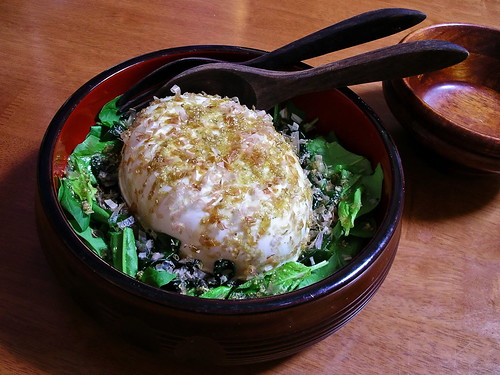
The base is spinach (as you can see, Japanese spinach has smaller, flat leaves) and wakame seaweed dressed with ponzu, ground sesame and sesame oil. Next is tofu, topped with katsuobushi and drizzled with a bit more ponzu.
That salad is beautiful smallworld, and I would really like to try it. I'm curious though, how is the wakame prepared exactly? Is it fresh? I'm perplexed as to how one might include dry wakame, which is the only available kind here. It doesn't seem like it would be much good without rehydrating it first, and then it seems like it would be necessary to cut it into small bits. Also, what firmness of tofu do you use? It seems like you're using something similar to what I would call silken tofu as you didn't cut it up. Silken tofu hasn't been pressed, and can easily be broken into pieces.
-
So that's my kitchen, and this brings my week to an end. My apologies for burning out towards the end of the week, I didn't prepare myself for the difficulties of blogging as well as I might've liked.
As I mentioned above, this is a fairly normal week in my life. More food related activites than I would do normally in schoo, but not by a huge margin. It takes a lot more time when you have to document it all and write about it.
For those of you who wanted to see schwart'z, I'm sorry I never made it there, but truthfully Schwartz is very old hat to me, and not somewhere I really wanted to go. As you may have guessed by now I am largely an introvert, and am mostly wrapped up in the world of my own cooking projects. For those of you planning to come to montreal and needing advice or where to go, what to eat, and what to see, I would suggest An Endless Banquet. This montreal foodblog has all the information you'll ever need and more, done better than I could have by any means.
I hope you enjoyed my week of blogging, and would love to hear from you if you ever come to montreal. Most people my age aren't really interested in cooking, so I am a bit starved for conversation with people who appreciate food as much as I do. I'd be more than happy to have a chance to check out some great montreal restaurant with an egullet, or if the timing is right, have you over for dinner.
-
So I had planned on making dinner tonight, but after a long week and with a lot of things in my mind, I ended up passing out and sleeping much longer than I intended to. Thus far the week has been more or less an accurate representation of my life, but a bit higher volume of cooking than I might normally do. I've certainly had weeks like this before, or where I've done even more, but never with the same level of other obligations to school, work, etc.
Here are some photos I took of my kitchen earlier. My kitchen is very important to me, and although there are still a lot of things I want to do it, I am satisfied with its level of functionality at present.
These photos are of what I think of as my "prep" area. Not too long ago I went to Ikea and bought some pot racks and shelves to create a corner in which to work. My kitchen doesn't have a lot of shelving and or counter space, so this corner made a huge difference once I finally got it up and running.
On the shelves I keep most of my asian condiments, teas, oil, and others stuff that I use frequently in cooking.
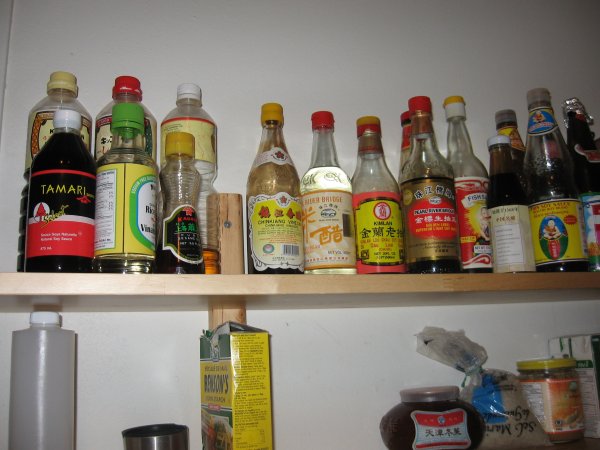

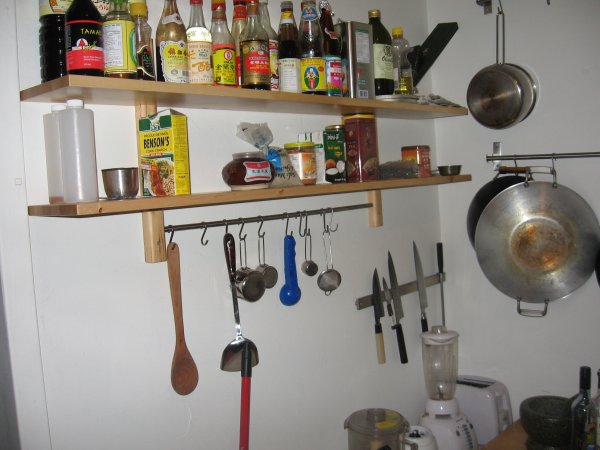

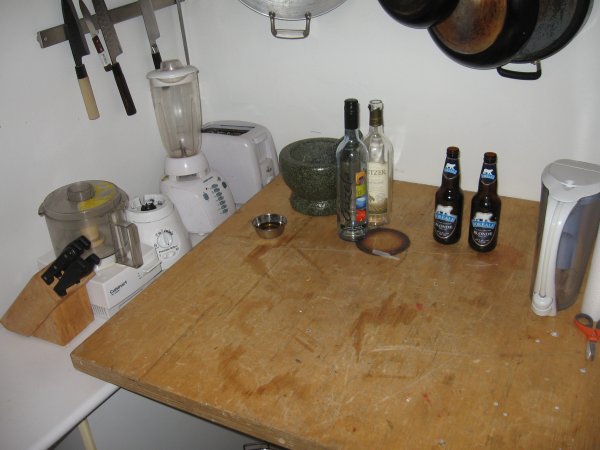
This prep table I recently inherited from work after we got some new tables there. It is working quite well as I was dying for flat space before we had this. The appliance counter thing to the left I got off the street, it isn't ideal but it is certainly functional and for the right price. I feel a bit like my kitchen is pieced together from odds and ends, but I can't complain. People really do throw away perfectly good stuff so often here.
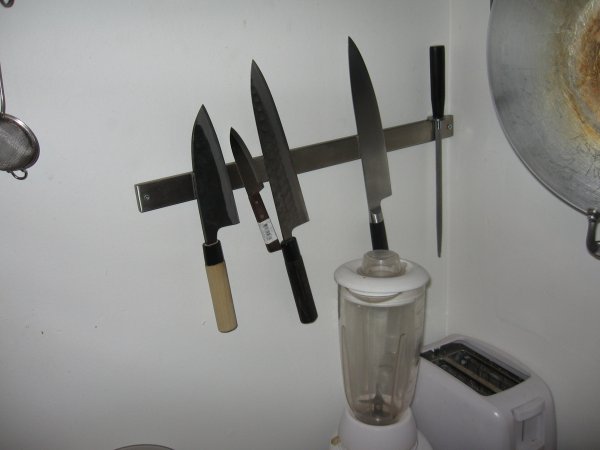
Here we have my knife rack. From left to right: Tosagata Deba, kiwing paring, yoshikane gyuto, kershaw shun chef's knife. The tosagata and yoshikane are recent acquisitions, and I love them both. They are such a pleasure to use. The deba I thought was going to be a traditional single bevel knife, as it is carbon steel and from a traditional maker in japan, but for some reason it isn't. I still love it, it's very tough and great for breaking down fish and poultry. I often use to chop chicken bones into small bits to make stock faster. The yoshikane is also great, it doesn't have much of a belly, so sometimes I use the shun for rocking, but it makes such a huge difference when cutting meat.
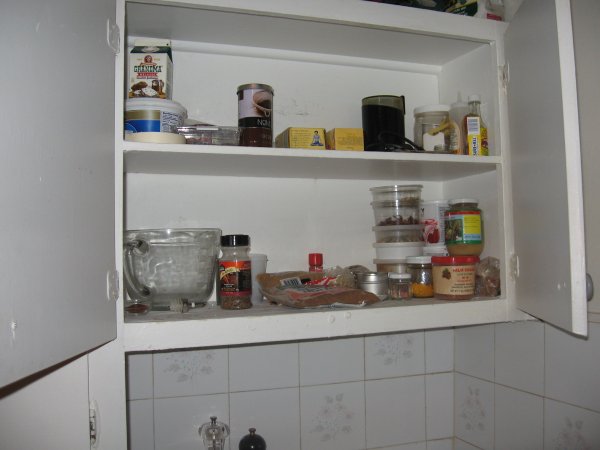
This is the cabinet above my stove, where I keep baking supplies and other odds and ends.

A little stoveside spice rack. I rotate in and out the spices I need (literally) on hand for this one.

My stove.

Another street acquistion, but quite useful. Unfortunately there isn't any great place to put this, so it makes it a bit difficult to get to the bathroom in back. The cabinet on the left is for alcohols and rices. As you can see, we eat a lot of rice.
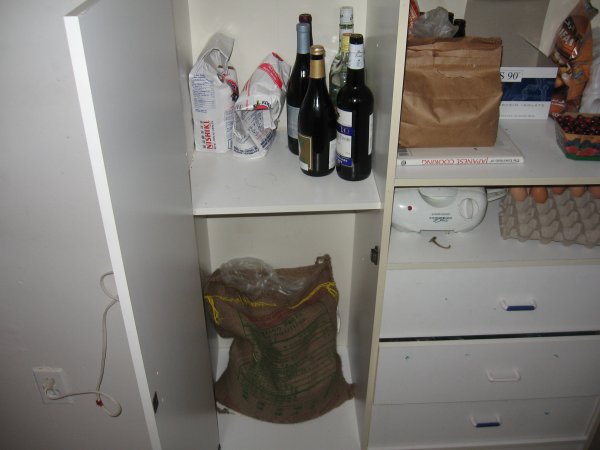
The Japanese drawer:

Spice drawer:
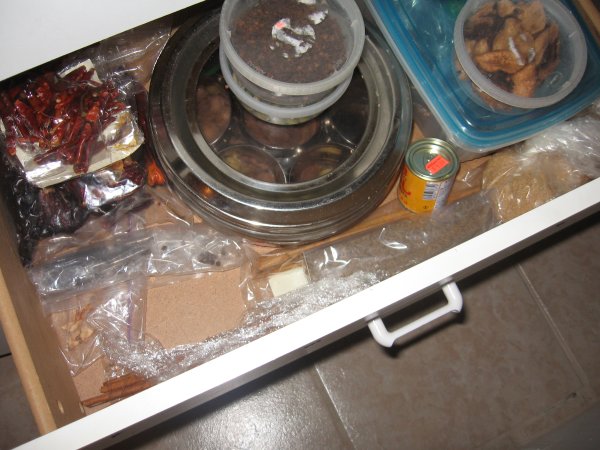
Sichuan Drawer:
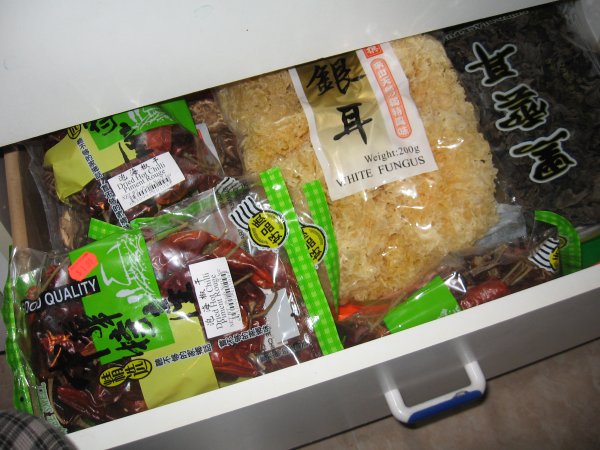
My Pantry:
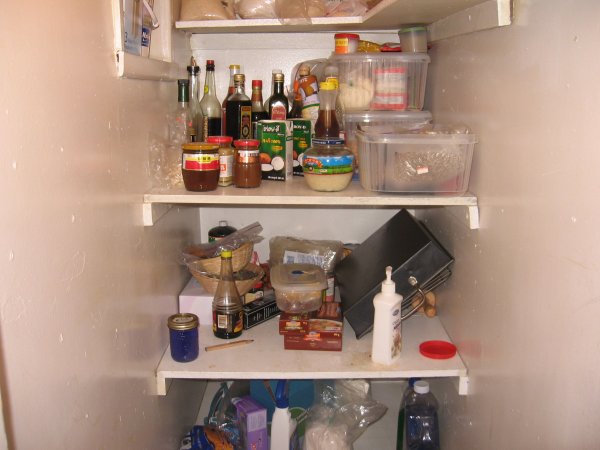
Spacious, but quite far from the kitchen itself. Since getting more space in the kitchen, it has become a bit disorganized.
My freezer:

In the forefront is avocado sorbet, something I forgot to mention. A recent experiment of mine, it is pure and simple with only avocados, sugar, water, lime juice, and a pinch of salt. There's so much fat in the avocados though that it comes out almost like ice cream.
My Fridge:
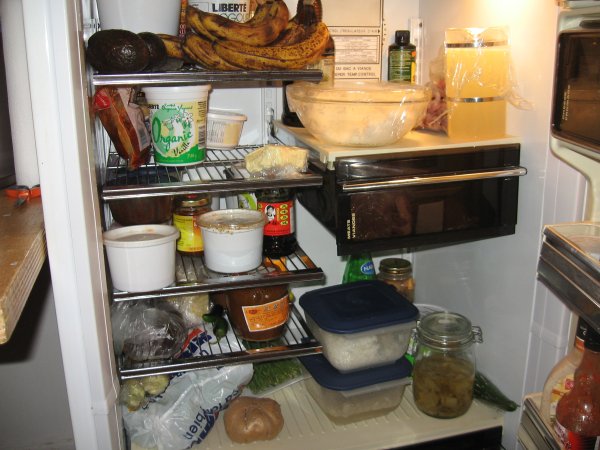
Fridge door:

Most of this is my cousin's. As I mentioned, I don't have much pre-prepared stuff.
-
Fortunately, I have access to excellent Sichuan pickled chillies. But then, I'm in China.

Ah right, how silly of me! Ah well, the search continues. Might I ask you to describe the chiles you use a bit, or post a photo? I've read descriptions of a few different kinds that are commonly pickled in my books, but it would be lovely to see them.
-

鱼香茄子 Fish Fragrant Aubergine (Eggplant)
I've been wanting to try a lot of fish fragant dishes, but haven't been able to source good pickled chilies. What do you use for pickled chilies? Incidentally, does anyone have a recipe for sichuan style pickled chilies (pickled with salt, wine, spices, not vinegar)?.
-
Apologies for the long delay, I was out late last night and then left early again for breakfast, and only just got home a short while ago.
Breakfast today was a bit of a change of pace. I recently learned that my girlfriend is pretty handy at making pancakes, so I headed over to her place to see for myself. Unfortunately I forgot to bring the camera, but I was quite satisfied with the results, save for the lack of maple syrup. Interesting she added a bit of whole wheat to her pancakes, which seemed to improve their character.
That aside, last night we went to Hwang Kum, a tiny almost whole in the wall korean restaurant located in NDG, a neighbourhood west of downtown.
I was quite eager to try this place out as I had heard great things about it, and am very fond of Korean food even though I don't know much about it. I have a lot of korean friends in Portland Oregon, where my parents live. And whenever I back to visit I always ask one friend if I can come over to his place for dinner (his mom is an excellent cook). Inevitably she always ends up cooking a big feast, and I am always more than satisfied. This past summer when I went to visit my parents he was out of town though, and I felt cheated out of my korean meal.
When we arrived they were quite busy, but after a short wait we were seated and served piping hot barley tea. I was feeling good vibes already, as the place was quite cozy and run by of staff of only three in a tiny kitchen! Apparently they knew what they were doing, as everything was excellent. I neglected to write down the korean names, but here is what we had:
We started with a seafood pancake:
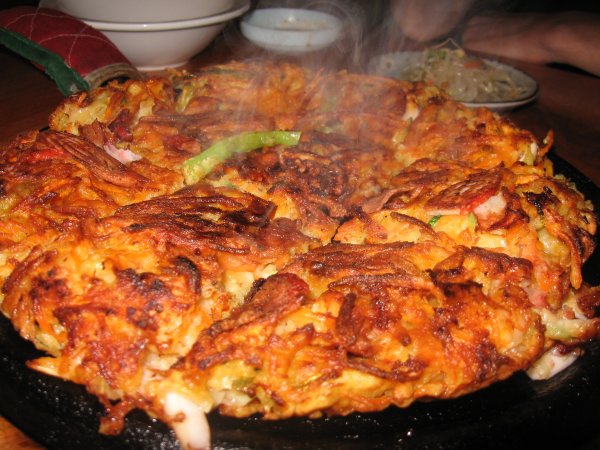
A korean friend introduced this dish to me a few months ago, and I enjoyed it so much I had to try it here. It arrived sizzling hot on a cast iron platter with bowls of dipping sauce. This was my favorite of the night, and an amazing value for the size of the pancake. So crispy.
For the main meal we shared a grilled eel accompanied by rice, various pickles & vegetables, and a spicy beef and vegetable stew.
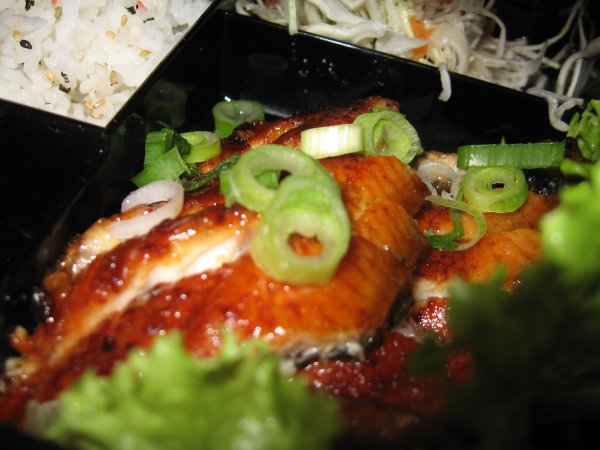
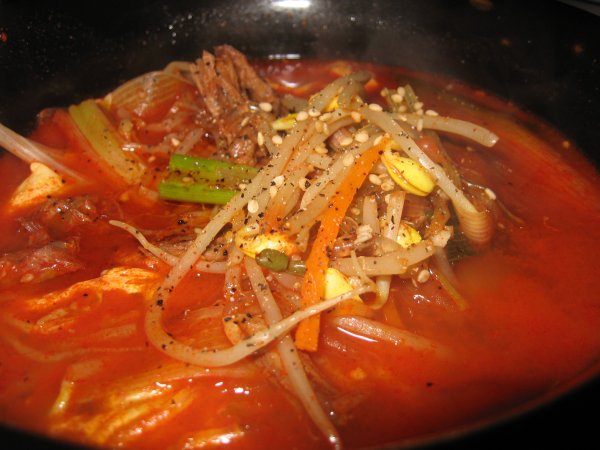
These were also both very tasty. The grilled eel was very similar to japanese Unagi, and the stew a rich chilie based red broth with tender chunks of beef and transparent noodles.
The portions were huged, so the three of us were quite stuffed with just these three. The bill came to 60$ tax and tip w/ drinks; I'll definitely be coming back.
I'll be back later on to post some photos of my kitchen and dinner, and answer any questions anyone might have.
-
So after a long week I'm a bit worn out and decided to take it easy today. Breakfast was more st-viateur bagels, and a few spoonfuls of raspberry sorbet. Continuing on this them I'll be checking out a korean restaurant I've been meaning to try for a while, but before that I'll be messing around in the kitchen a bit.
-
I forgot to mention the drinks with dinner. Nathalie was kind enough to select and bring the wine.
We had a sparkling wine to drink while prepping:
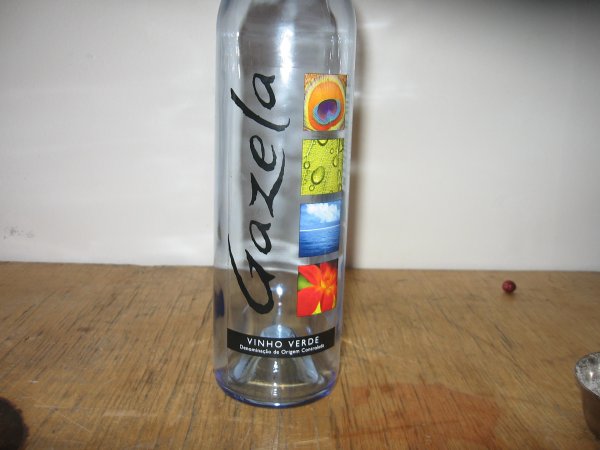
This was quite nice, very citrusy and easy to drink.
For the appetizer we had a few beers. I find beer goes very well with almost all Sichuan food.
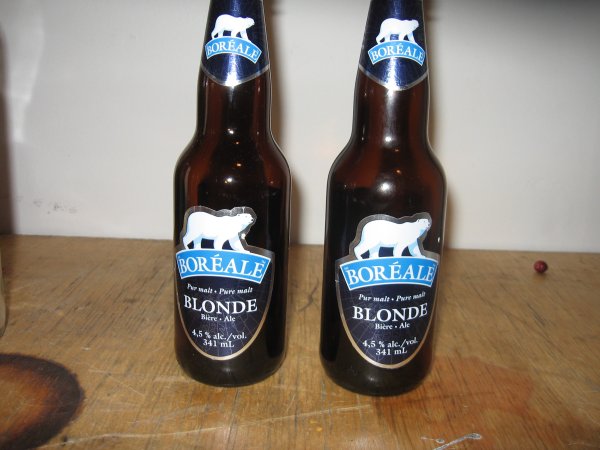
To go with the main meal we had this Fume blanc from california.
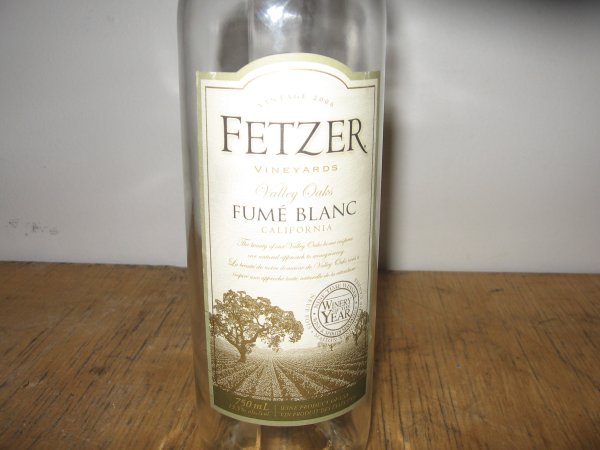
This was even better. It had a deep flavor with some notes I couldn't quite put my finger on, grapefruit maybe?
And for desert we had Chocolate and Raspberry sorbet.
Raspberry sorbet as a natural choice with the raspberries I picked up earlier. Delicious and well paired to the chocolate (this one I made late in the day, and was very difficult to quenelle).
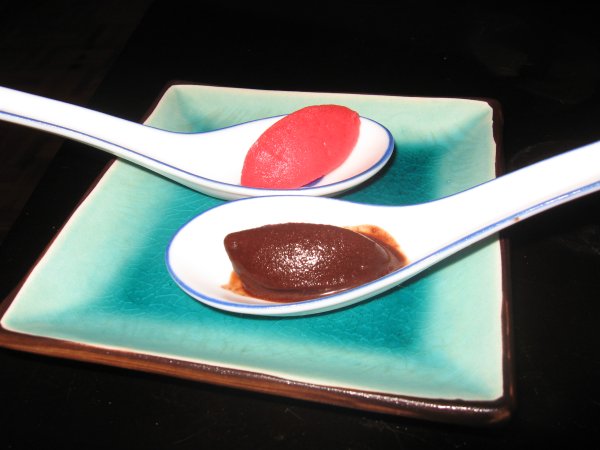
Nathalie mentioned to her the other day that she was a fan of dark chocolate ice cream, and I asked her if she had tried chocolate sorbet. I told her that true chocolate fans didn't care for dairy messing with their chocolate flavor, so naturally I had to make it for her to try out. I used this recipe. I'm not sure why the cocoa powder is in there though. Even though the stuff I used was good quality, I can't help but feel that it only took away from the chocolate (michel cluziel, 70%); it also seem to contribute some graininess to the the texture. I think I may try a version with just chocolate. Anyone out there who can recommend a great chocolate sorbet recipe?
-
So my friend Nathalie came over tonight to cook Sichuan food with me. Here is what we made:
Appetizer: Beef slivers with sesame seeds (zhi ma niu rou si):
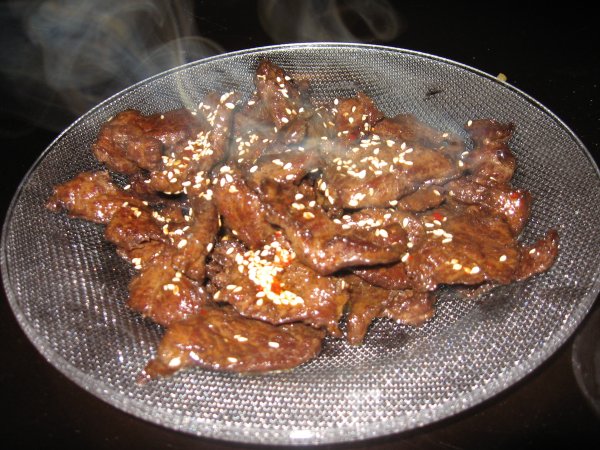
This was an interested and very unusual dish. Slivers of lean marinated beef first deep fried until beginning to crisp, and then slowly simmered in a soy based sauce fragent with star anise and cassia until glazed, finished with sesame and chilie oil and garnished with toasted sesame seeds. Wildly overcooked by western standards, the beef had a chewy texture not dissimilar to jerky. I really liked this, it was deliciously chewy and flavorful with the sauce.
For the main meal we had Prok slivers with preserved mustard tuber (zha cai rou si), and Dry fried green beans (gan bian si ji dou):

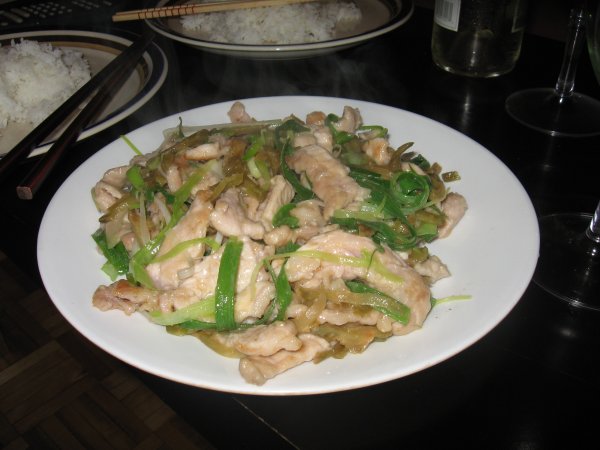
The beans were a vegetarian version of a Sichuan classic. I opted for the vegetarian version as there was already plenty of meat in the meal. They were very tasty, plenty of wok hei and coated with an oil subtly laced with garlic, ginger, scallions, sichuan pepper, and dried red chiles.
The pork was also very good. Tender strips of pork interspersed with slivers of Zha Cai, a preserved vegetable from Sichuan that is simultaneously salty/sour/spicy/pungent.
And as per the sichuan custom we finished with soup. Chicken soup with pickled mustard greens (suan cai ji si tang):
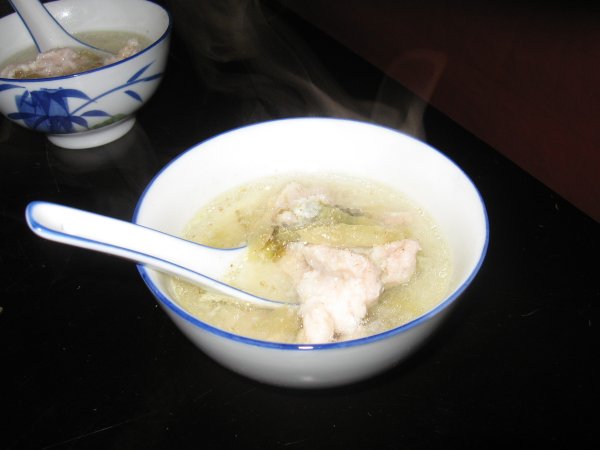
A delicate soup, savory from stock and slightly sour from the pickled mustard greens. It filled the mouth nicely, as it was slightly thickened by cornstarch and egg white. It made for a pleasing palate cleanser between the broth, tender strips of chicken, and occasional bursts of pungent white pepper.
-
Gabriel, I have been 'offline' for awhile now and am now marginally 'online' and finally have caught up on the food blogs and am up to date! I am so glad to see you blogging! Montreal is one place that Mr. Kim and I are considering going to, perhaps next year or the one after that. The care and time you take to make your meals is really inspiring! I am fascinated with your food and your city!
Kim
Thank you for your kind words Kim. If you do manage to find your way to montreal, I think you will find it well worth your while. There is no other city quite like it in North America, and in other respects the world.
-
Wow, Gabe! What a wonderful year it has been for all. I love this time of year. We get the fall crops, it has been warm enough that tomatoes and peppers are still there, and we are (at least in Minneapolis) seeing the return of the cool weather crops like lettuce and beautiful spinach. Plus apples, and squash, etc., etc.
You've mentioned up topic about how you delve into a particular cuisine rather intensely. I notice a more Asian bent in your obsession. Comments?
Yes fall time is my favorite time of year at the market, every other season pales in comparison. The selection of peppers seems to get steadily better each year, there is quite a variety of them available right now. Unfortunately I am not too impressed by our market tomatoes; better than supermarket but a far cry from homegrown or some of the ones I have had from farmer's markets elsewhere.
As for my leanings, what can I say; I like strong flavors. Not to say that I don't enjoy or appreciate western cuisine. I am interested in food and cooking in all its forms, its just that most western food doesn't get me really fired up. The things I really want to devote my time to are flavors and techniques I have never seen or heard of before. There is a whole great wide world of cooking out, infinitely vast and varied, and largely undiscovered. To me this world is just that much more interesting than the largely francocentric (with some italian) cooking of the west. It isn't just restricted to Asia though; I am also very interested in the cooking of latin and south america, persia and the middle east, and to some extent africa. To date the cuisines I have covered thorughly and would consider myself competent in are Indian, Mexican, Thai, and now I am learning some sichuan/japanese. The ones I am definitely planning on getting to beyond these are peruvian, vietnamese, and korean. I also plan to revisit the first five and explore them more thoroughly, region by region (maybe not all the regions, but the ones that interest me most), rather that treating them as a whole "unified" cuisine.

Woks - Buying, Care, and Use
in Kitchen Consumer
Posted
Takadi, I think I had the same perception as you when I first started cooking with a wok: hot equals better. But now with a lot more experience cooking from reliable books, and observing friends/friends parents cooking, I think its something of a misnomer.
In formal restaurant cooking, there is complicated qualification scheme for different types of cooking/different levels of heat, and the explosive super high heat your talking about is only one technique in a range of many. It definitely produces fantastic results for certain dishes with the right setup and a lot of skill, but wok cooking is by no means limited to this explosive frying. I also might add that you can't directly equate BTU to heat output; it's more complicated on that. It's going to depend on the individual characteristics of your heat source, pan, setup, etc.
My advice to you would be to pursue that explosive heat, but not to obsess about it. Sometimes you have to make compromises to get a good result. I obsessed too much in the beginning, and I think it really hampered my progress until I finally let go, and now I feel i have a much better understanding of the basic principles.